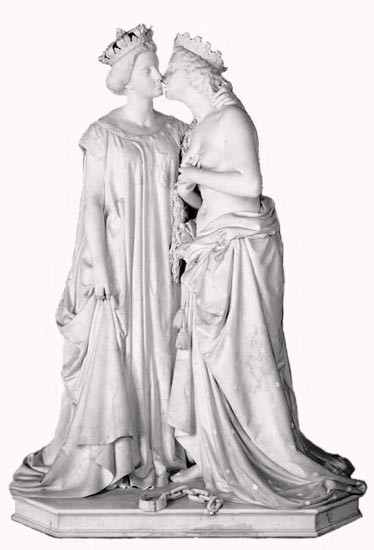Vincenzo Vela, a Swiss sculptor of Italian origin, originally trained as an engraver before turning to sculpture. He quickly moved away from the neo-classical aesthetic espoused by the followers of Canova and instead looked to a ‘truer’ form of sculpture (what would become the Verismo movement). The leading light of the Naturalist school, he was to become the most famous Italian sculptor of the latter half of the 19th century.
He was extremely active, politically speaking, and took part in the Sonderbund war in 1847, serving under General Dufour. In 1848, he was involved in the revolutionary struggles against Austria. After the Italian patriots had been defeated, he returned to Milan where he made a living from private and public commissions. It was with one of these Milan creations that he was to make his name. His Spartacus, completed in 1850, was embraced as a symbol of the struggle against the Austrian yoke. Ten years later, he completed another allegorical composition, this time celebrating Lombardy’s newly-found freedom. A group of female patriots in Milan, looking to thank Eugénie in acknowledgement of France’s support during the 1859 conflict, launched a campaign for subscriptions in order to finance the artistic project. Vincenzo Vela’s sculpture prevailed. In it, France receives a kiss from a liberated Italy, whose broken chains lie at her feet. With her left hand, France, dressed in a long and flowing tunic and wearing the imperial crown, is gently pulling Italy towards her in a protective gesture. Italy’s partial nudity is doubly significant, demonstrating both the fragility of this newly-formed nation, until recently enslaved by a foreign power, and an emancipation that is still to be completed and must be defended.
The sculpture was presented to the Empress Eugénie on 1 January, 1863, and went on display at the Salon of that same year, entitled La France et l’Italie and bearing the note “presented to HM the Empress by the women of Milan”. On the sculpture’s wooden base is a plaque with the following dedication: A EUGENIA IMPERATRICE / NELL’ESULTANZA/DELLA PRIMA VITTORIA/ CHE RENDEVA LA PATRIA A SE’STESSA/ LE DONNE MILANESI/ GIUGNO MCDCCCLIX (To the Empress Eugénie, in the elation of the first victory which liberated the fatherland, the Milanese women, June 1859). During the Second Empire, the sculpture stood in the Grand Trianon in Versailles, where it remained until 1937 when it was moved to Compiègne. The plaster model resides in the Museo Vela, in Ligornetto, Vela’s birthplace.
The artist devoted his entire career to works celebrating the Italian risorgimento (Italian unification) and the individuals involved, completing statues paying homage to Cavour (1861-1863), Victor Emmanuel II (1865) and Garibaldi (1888-1889).
Karine Huguenaud (tr. & ed. H.D.W.)
Napoleon.org also features a presentation of Vela’s famous work, “Napoleon dying”.
February 2010


